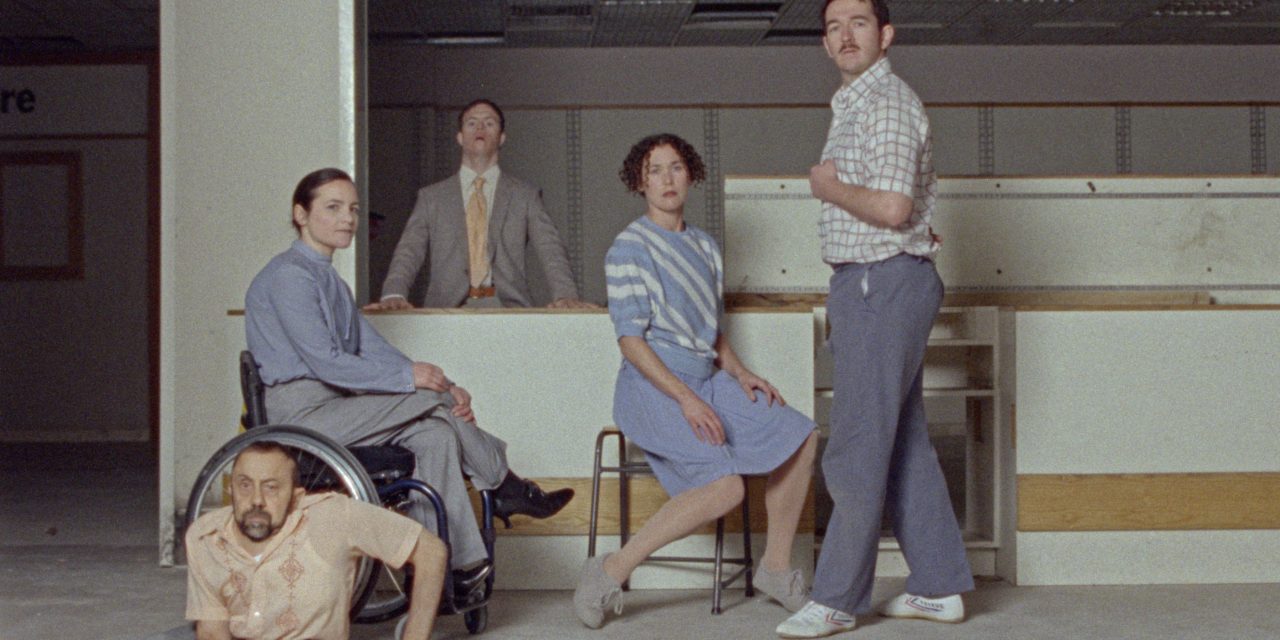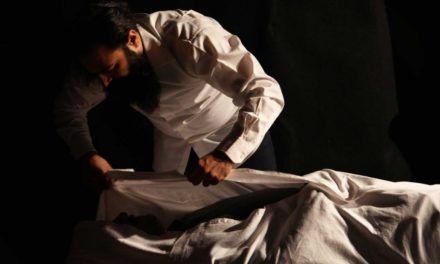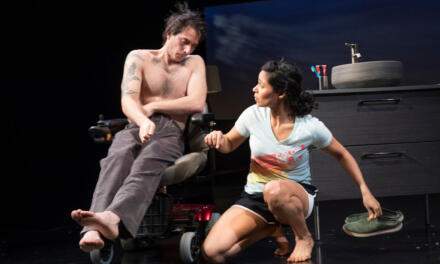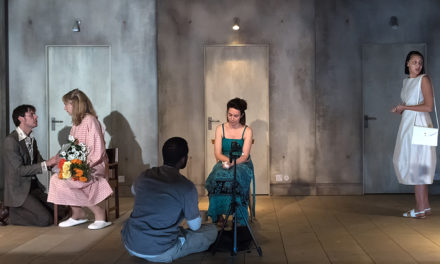Artificial Things [i] (directed by Sophie Fiennes) is a re-imagination of a contemporary dance performance of the same title by Stopgap Dance Company (choreographed by Lucy Bennett and devised by the dancers: Amy Butler, Laura Jones, Chris Pavia, David Willdridge and Dave Toole). Stopgap is a UK-based ensemble which integrates disabled and non-disabled dancers and artists, operating with a distinctive movement aesthetic, and collaboratively developing work that “seeks to open a window into a parallel world where human interdependence, strength, and vulnerability play out with poetic realism.” [ii] Their original, 90-minute dance piece, Artificial Things (2014), gained so many accolades in Britain that it became part of the GCSE curriculum in secondary schools. Hence the genesis of this film: to record an excerpt from the company’s landmark performance with the aim of documenting and preserving an ephemeral artwork.
Having worked with dancer-choreographer Michael Clark in the 1990s (a formative experience that resulted in a film, The Late Michael Clark, 2000), as well as documenting and interpreting one of the most contested performances of les ballets C de la B (VSPRS Show and Tell, 2007), Fiennes in her previous dance-documentaries reveals a filmmaker who not only understands contemporary dance from within but speaks its vocabulary with sensitivity and confidence.
The viewer of Artificial Things (2018), however, is presented with something different from Fiennes’s previous works: a dance film that grew out of the process of documentation, a new artwork in its own right.
Focusing on the third part of the dance piece, Fiennes condensed the original 90-minute performance to less than half an hour. During this distillation process, she changed the piece’s dramaturgy and inserted scenes from the first two parts of the original, full-length work. Fiennes then completely re-arranged the scenes (the solo, the duets, and the ensembles), using an artificial logic, a simple principle from mathematics: ordering them in a geometric sequence from one to five, according to the number of dancers in each.
Bennett and Fiennes decided to relocate the space of the original show (a traditional, end-on staging in a theatre) to a non-theatrical, found location–an abandoned shopping mall–and explored the possibilities it offered for re-thinking and re-creating the choreography. With this the mise en scène became a mise en lieu, which completely re-contextualized the original piece, creating a desolate, abandoned, real world for its characters’ dystopian existence.
Fiennes and Bennett in their collaboration further rethought the piece. The markedly theatrical costumes of the original performance (designed by Anna Jones) in the film are replaced with costumes which use more muted tones. The cream, grey, pastel-blue, soft peach, and brown colors, and the more formal attire recall the aesthetic of the 1950s and evoke some post-war melancholy.
When creating the original dance piece, Bennett and Jones were inspired by the paintings of a contemporary Berlin-based Serbian artist, Goran Djurović. In the film, Bennett and Fiennes further explored this stimulus. The color scheme of the costumes was influenced by the work of Djurović, and the compelling senses of light and space in those paintings were translated into the visual language of the film. Using the found light sources of the space, Fiennes and cinematographer Remko Schnorr paint with the lighting and create a destitute, forlorn atmosphere contrasting darkness with shafts of white light coming from the ceiling, softened occasionally by smoke.
The space plays a vital part in the film: it is a post-apocalyptic, surreal, but charged environment, almost breathing together with the moving figures (somewhat reminiscent of The Zone in Tarkovsky’s Stalker). The glass walls obscured by white paint (to keep out the unwanted gaze), the distressed lino, the bare counter by the hollowed partition walls, the remains of signs, the cracked mirror mended by thick yellow and orange tapes–bear traces of a once abundant and busy life. The soundscape (kept from the original dance piece, created by Andy Higgs and Jim Pinchin) contributes to an industrial, remote and melancholy feeling, giving an impression that here time stands still.
The characters who appear in this desolate and broken space are abandoned, lonely, feeble and somewhat frustrated. Archetypical, yet surreal creatures, who, like disparate survivors of a catastrophe, slowly come to their senses.
The disabled dancers uncover and display their physicality in a matter-of-fact way, without sentimentalism. It is an unavoidable and perhaps unusual experience for the viewer, but at the same time, it offers a deeper level of connection. The movements (mainly based on the vocabulary of contact improvisation) explore the possibilities of and the boundaries for these bodies–not without a sense of humor. Yet they also express an inner landscape and reveal frustration, aggression, self-hatred, sadness, and affection.
The non-disabled dancers’ duet begins from the cultural topos of a mixed-sex couple’s “lead and follow” movements, yet as it unfolds, the traditional gender roles become more playful and relational, and the dance settles on a tender balance between the partners in weight-bearing and lifts, gently emphasizing the male–female dialogue in equality.
A recurring motif in the choreography is the dialogue (or the lack of it). Through the dancers’ gentle interaction (in the duets and quartets), gradually intimacy and connection develop–until disabled and non-disabled people and a broken wheelchair become one, interconnected union on the ground. From this pulsating group, through a lift, a beautiful, elevated image marks the synthesis, which might be interpreted as a moment of apotheosis or perhaps outstretched arms to the transcendental–but there is nothing, only the cold lights above.
What can become of this unusual group of no-longer strangers? The ending hints at Fiennes’s optimism (utopia?): revealing a deep humanism with a sense of humor that is so characteristic of her work. The film starts and concludes with an empty space. However, what looks like a hopeless end at the beginning becomes a promising beginning at the end.
Notes
[i] Artificial Things will see its European premiere at the International Documentary Film Festival Amsterdam on November 17, 2018. The following day, at the IDFAcademy: Meet the Professionals Special, director Sophie Fiennes will discuss the film and her previous works, including The Pervert’s Guide To The Cinema (2006) and Grace Jones: Bloodlight & Bami (2017).
[ii] Excerpt from the company’s website: https://www.stopgapdance.com/about
This post was written by the author in their personal capacity.The opinions expressed in this article are the author’s own and do not reflect the view of The Theatre Times, their staff or collaborators.
This post was written by Katalin Trencsényi.
The views expressed here belong to the author and do not necessarily reflect our views and opinions.


















